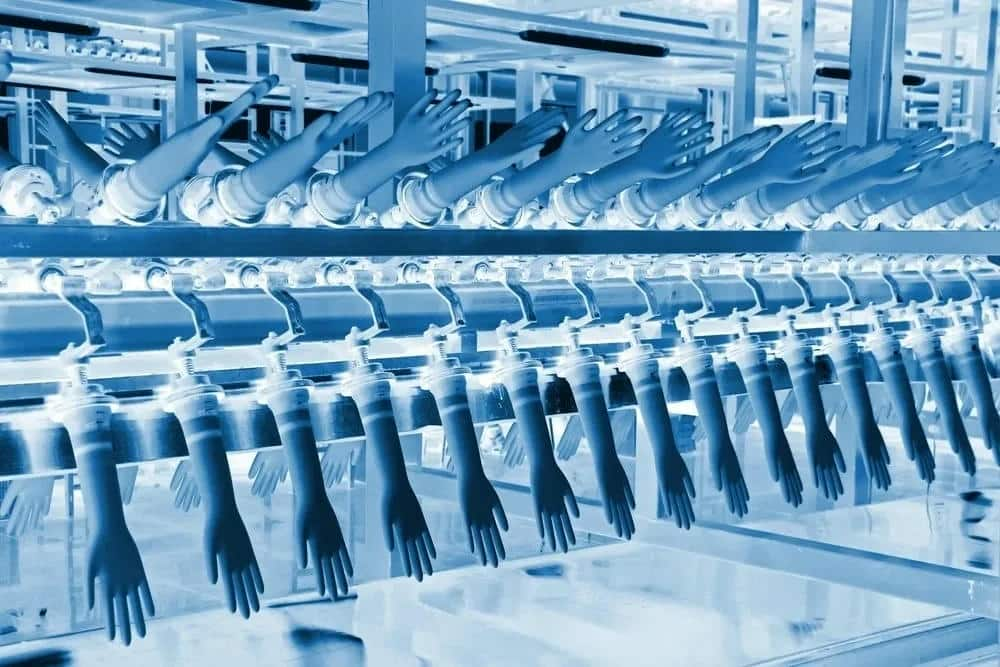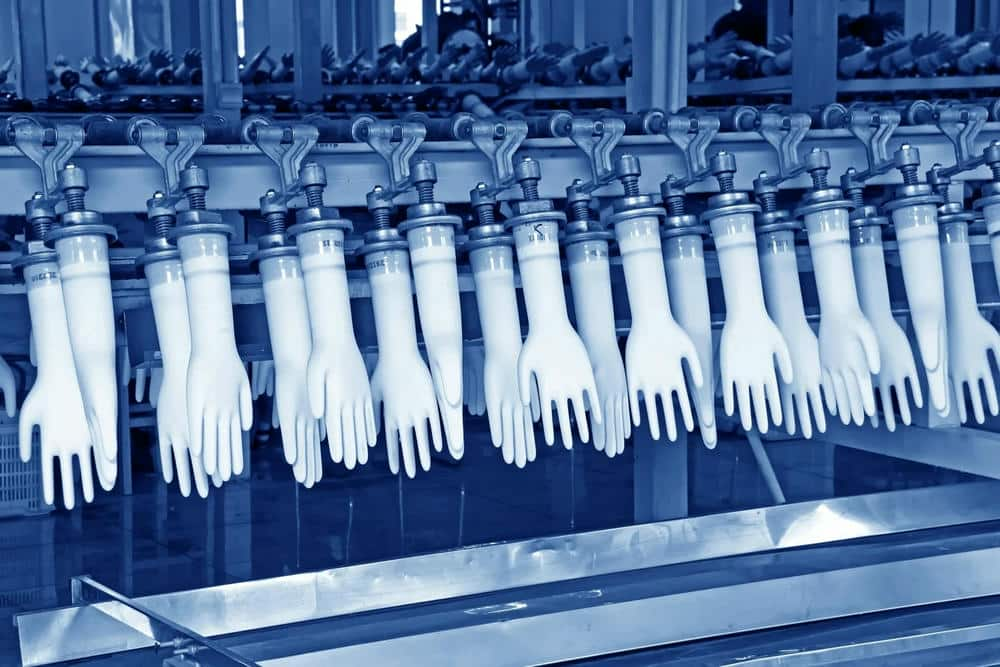So, you’re in the market for nitrile gloves? You’ve come to the right place. Choosing the right nitrile gloves manufacturer can feel overwhelming with so many options out there. It’s like trying to pick a single coffee bean out of a giant silo – a bit daunting, right?
This guide will break down everything you need to know about navigating the world of nitrile gloves and finding the perfect manufacturing partner for your needs.

Why Are Nitrile Gloves So Popular Anyway?
First things first, let’s address the elephant in the room – or should we say, the glove on the hand? Why are nitrile gloves so popular these days? Well, for starters:
- They’re the Goldilocks of gloves: Nitrile provides excellent protection against punctures, tears, and a wide range of chemicals, striking a perfect balance between durability and dexterity.
- No latex drama: For those with latex allergies, nitrile gloves are a lifesaver (literally!). They offer similar barrier protection without the risk of allergic reactions.
- Versatility is their middle name: From healthcare and food service to automotive repair and industrial cleaning, nitrile gloves are the go-to choice for a diverse range of industries.
Key Factors to Consider When Choosing a Nitrile Gloves Manufacturer
Finding the perfect nitrile gloves manufacturer is like dating—you wouldn’t just settle for the first one you meet, right? It’s all about finding the best fit for your needs and values. Here are the key factors to consider before saying “I do” to a supplier:
1. Quality Comes First (Always!)
This is non-negotiable, folks. The quality of your nitrile gloves directly impacts the safety of your workers and the reputation of your brand. Always look for manufacturers who:
- Hold relevant certifications: ISO, ASTM, and EN standards are a good indicator of quality control and product reliability.
- Offer detailed product specifications: Look for information on thickness, tensile strength, and chemical resistance to ensure the gloves meet your specific needs.
- Provide samples for testing: Don’t be shy about requesting samples to put the gloves through their paces in real-life scenarios.
2. Production Capacity: Can They Handle Your Needs?
Imagine this: you’ve landed a massive order, only to find out your manufacturer can’t deliver on time because they’re short on capacity. Nightmare fuel! Always check the manufacturer’s production capacity and lead times to ensure they can handle your current and future needs.
3. Location, Location, Location (and Shipping Costs)
While globalization has made it easier to source goods from all over the world, location still matters, especially regarding shipping costs and delivery times.
- Consider the distance: Longer shipping distances can lead to higher costs, longer lead times, and a larger carbon footprint.
- Explore regional options: Opting for a nitrile gloves manufacturer closer to home can often streamline logistics and reduce transportation costs.
4. Pricing: Finding the Sweet Spot
Let’s face it—budget is always a factor. However, be wary of manufacturers offering prices that seem too good to be true. They often compromise on quality or cut corners, leaving you with subpar gloves. Aim for a supplier who offers competitive pricing without sacrificing quality.
5. Beyond the Gloves: What Else is Important?
Beyond the actual gloves, several other factors come into play when choosing a manufacturer:
- Customer service: Are they responsive, helpful, and committed to resolving your concerns?
- Minimum Order Quantities (MOQs): Can they accommodate your order volume, or are their MOQs too high?
- Payment terms and conditions: Do they offer flexible payment options and favorable terms?
Unmasking the Nitrile Gloves Manufacturing Process
Ever wondered how nitrile gloves are actually made? Here’s a sneak peek behind the scenes:
- Compounding: The process starts with mixing raw nitrile butadiene rubber (NBR) with other additives to enhance desired properties, like color, elasticity, and chemical resistance.
- Dipping: Hand-shaped molds (formers) are dipped into the liquid NBR compound to create the glove shape. The formers are then rotated to ensure even coating.
- Leaching: The gloves undergo a leaching process to remove any residual chemicals.
- Stripping: Once dry, the gloves are carefully stripped from the formers.
- Cuff Rolling: The glove edges are rolled to create a comfortable and secure fit.
- Quality Control: Each glove undergoes rigorous testing for pinholes, tears, and other defects to ensure it meets quality standards.
- Packaging: Finally, the gloves are inspected, counted, and packed for shipping.

Types of Nitrile Gloves and Their Applications
Nitrile gloves aren’t one-size-fits-all. Just like tools in a toolbox, different types cater to specific tasks. Here’s a breakdown of common types and their uses:
| Type of Nitrile Glove | Features | Applications |
|---|---|---|
| Exam Grade | Non-sterile, single-use, versatile | Medical examinations, food handling, light-duty cleaning |
| Surgical Grade | Sterile, single-use, precise fit | Surgical procedures, high-risk medical environments |
| Industrial Grade | Thicker, more durable, resistant to harsh chemicals | Automotive repair, industrial cleaning, manufacturing |
| Powder-Free | Easier to don, eliminates powder residue | Medical examinations, laboratories, cleanroom environments |
| Textured | Enhanced grip, ideal for handling wet or slippery objects | Medical procedures, laboratory work, mechanical tasks |
The Global Nitrile Gloves Market: A Shifting Landscape
The global nitrile gloves market is a dynamic beast, influenced by various factors:
- Rising healthcare expenditure: The growing demand for personal protective equipment (PPE) in the healthcare sector remains a primary driver.
- Stringent safety regulations: Increasing awareness of workplace safety is driving the adoption of nitrile gloves across industries.
- Evolving manufacturing landscape: New manufacturers, especially in Southeast Asia, are entering the market, intensifying competition and potentially impacting prices.
- Supply chain disruptions: The COVID-19 pandemic highlighted the vulnerabilities of global supply chains, leading to fluctuating prices and potential shortages.
Partnering for Success: Choosing the Right Manufacturer
Ultimately, choosing a nitrile gloves manufacturer is about forming a partnership built on trust, transparency, and shared values. By carefully considering the factors we’ve discussed, you’ll be well on your way to finding a supplier who meets your specific needs and becomes a valued extension of your business. Remember, just like a good pair of gloves protects your hands, a reliable manufacturer safeguards your business and your peace of mind.
FAQs
1. What’s the difference between nitrile and latex gloves?
While both offer barrier protection, nitrile gloves are latex-free, making them suitable for those with allergies. They’re also more puncture-resistant and offer better chemical resistance.
2. How do I choose the right thickness for nitrile gloves?
Thickness is measured in “mils” (1 mil = 0.001 inches). Thinner gloves offer better dexterity, while thicker options provide increased durability and protection against harsh chemicals.
3. Are all nitrile gloves medical-grade?
No. While all medical-grade nitrile gloves are made of nitrile, not all nitrile gloves are medical-grade. Medical-grade gloves undergo stricter quality control and are often sterilized to meet specific standards for medical use.
4. Can nitrile gloves be reused?
It depends on the intended use and manufacturer recommendations. Generally, nitrile gloves are designed for single use, especially in medical and food handling settings, to prevent cross-contamination.
5. How do I dispose of nitrile gloves properly?
Always dispose of used nitrile gloves in designated waste containers. Follow local regulations and guidelines for safe disposal, especially for gloves used with hazardous materials.
6. What is the future outlook for the nitrile gloves market?
The market is expected to continue growing in the coming years, driven by the factors mentioned earlier. However, navigating supply chain dynamics and price fluctuations will remain crucial.
Conclusion
Finding the right nitrile gloves manufacturer can be challenging, but by prioritizing quality, understanding your needs, and considering the factors discussed in this article, you’ll be well-equipped to make an informed decision that protects your business, your workers, and ultimately, your bottom line. Remember, the perfect glove is out there – happy hunting!
MedicW is committed to being your trusted partner in providing high-quality medical consumables. Explore our comprehensive range of products and discover how we can support your healthcare needs. Visit us at medicw.com or contact our team at [email protected].
Link to this article: Finding the Right Nitrile Gloves Manufacturer
